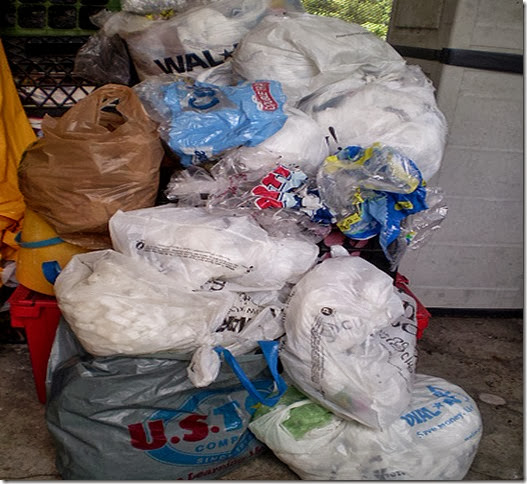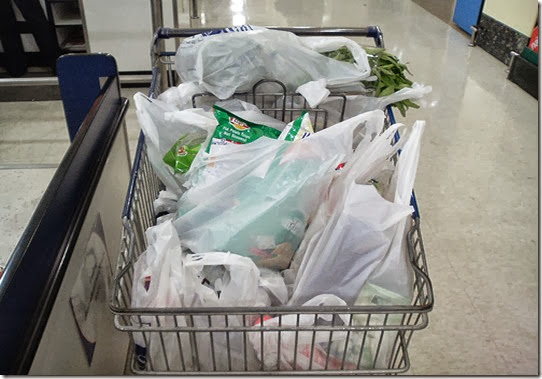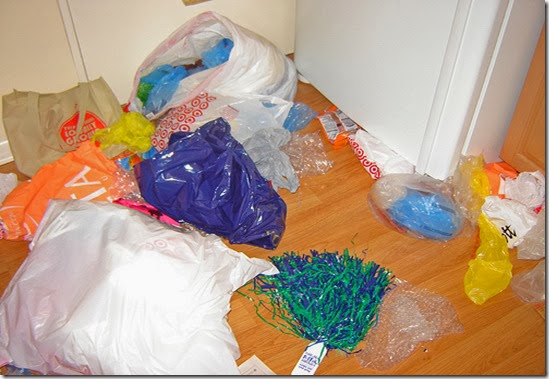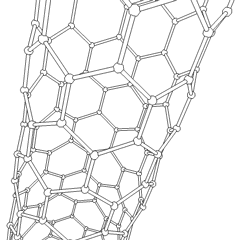 Plastic bags or Polythene carry bags , that’s what we say are getting so popular and have become as if an essential thing in our day to day life. These have surpassed in the matter of use over the grocery market since they were first introduced more than 30 years ago. Billions and Billions of them are used around the world each year. Most of these bags are non-bio-degradable and a majority of them still end up in landfills, which is now a serious matter of concern and an alarming effect to the whole world.
Plastic bags or Polythene carry bags , that’s what we say are getting so popular and have become as if an essential thing in our day to day life. These have surpassed in the matter of use over the grocery market since they were first introduced more than 30 years ago. Billions and Billions of them are used around the world each year. Most of these bags are non-bio-degradable and a majority of them still end up in landfills, which is now a serious matter of concern and an alarming effect to the whole world.
It has now turned as one of the most serious threats to our oceans is plastics pollution. It constitutes approximately 90% of all trash floating on the ocean’s surface, with 46,000 pieces of plastic per square mile. Since it is not bio-degradable, these plastic pieces are eaten by marine life, wash up on beaches, or break down into microscopic plastic dust, attracting more debris.
When they are thrown to dustbins, garbage cans, plastic bags do not simply decay unlike other biodegradable trashes like paper and leftovers. If they are scattered anywhere on the ground, they become the sources of water pollution. Plastic is also swept away by ocean currents, landing in swirling vortexes called ocean gyres. These floating garbage sites are impossible to fully clean up.
 There are many negative impacts that can cause by plastic bags. Plastic poses a significant threat to the health of sea creatures, both big and small. Over 100,000 marine mammals and one million seabirds die each year from ingesting or becoming entangled in plastic because plastic bags are made of various chemicals which are mainly toxic. That is certainly very harmful to the health and the environment.
There are many negative impacts that can cause by plastic bags. Plastic poses a significant threat to the health of sea creatures, both big and small. Over 100,000 marine mammals and one million seabirds die each year from ingesting or becoming entangled in plastic because plastic bags are made of various chemicals which are mainly toxic. That is certainly very harmful to the health and the environment.
 It takes 500-1000 years for plastic to degrade. Even if we stopped using plastics today, they will remain with us for many generations, threatening both human and ocean health.
It takes 500-1000 years for plastic to degrade. Even if we stopped using plastics today, they will remain with us for many generations, threatening both human and ocean health.
Since it’s a big matter of concern and an alarming to threat to the whole world, so despite these alarming facts and cons, there are several actions taken to address and overcome the problem of plastics. One of them is the successful production of essential Carbon Nanotubes from these waste plastic bags.
What is Carbon Nanotubes:
Carbon nanotubes are tiny cylinders of carbon atoms, one nanometer in diameter (1/10,000 the diameter of a human hair). They are the strongest and stiffest materials yet discovered - hundreds of times stronger than steel but six times lighter - and their unique mechanical, electrical, thermal and transport properties present exciting opportunities for research and development. They are already used in a variety of industries including in electronics, sports equipment, long-lasting batteries, sensing devices and wind turbines.
The structure of carbon nanotubes can be observed by rolling up a graphite sheet plane to a tube. According to Dresselhaus and co-workers, the crystalline structure of CNTs can be characterized by the (chiral) roll-up vector R within a corresponding graphite sheet plane. R = ma + nb (m,n ∈ N), with vectors a and b describing the base unit of the graphite sheet plane. The roll-up vector results from the difference between the two grid points of the graphite lattice that coincide in a single grid point of the nanotube on the imaginary roll-up. The length defines the perimeter, the angle ϑ the helicity (chirality) of the nanotube.
 The potential for carbon nanotubes hinges on the industry’s ability to produce large quantities more cheaply and uniformly. Current synthesis methods involve complex processes and equipment, and most companies in the market measure production output in only several grams per day.
The potential for carbon nanotubes hinges on the industry’s ability to produce large quantities more cheaply and uniformly. Current synthesis methods involve complex processes and equipment, and most companies in the market measure production output in only several grams per day.
Carbon nanotubes are classified as per their structures and geometry: single-wall nanotubes (SWNTs), double-wall nanotubes (DWNTs), and multi-wall nanotubes (MWNTs). The different structures have individual properties that make the nanotubes appropriate for different applications. Because of their unique mechanical, electrical, and thermal properties, carbon nanotubes present exciting opportunities for scientific research and industrial and commercial applications.
Carbon nanotubes can also be effective semiconductors with the right arrangement of atoms. Scientists are still working on finding ways to make carbon nanotubes a realistic option for transistors in microprocessors and other electronics.
Advantages of Carbon Nanotubes
Carbon nanotubes have a number of valuable and unique properties, including:
- High thermal and electrical conductivity
- Optical properties
- Flexibility
- Increased Stiffness
- High tensile strength (100 times stronger than steel per unit of weight)
- Light weight
- Range of electro-conductivity
- Ability to be manipulated yet remain strong
What exactly behind this research:
To overcome the various negative issues generated by the waste plastic bags, Scientists of Adelaide University have developed a new way of producing Carbon Nanotubes, thereby lessening the various alarming effects of these plastic bags.
Scientists at Australia's University of Adelaide have developed a process for turning waste plastic bags like you get at the grocery store into “fine carbon nanotube membranes.” This high-tech nano substance is a sophisticated and expensive material with a variety of potential applications, including filtration, sensing, energy storage and other biomedical innovations.
Researchers at the University's School of Chemical Engineering had already been growing nanotubes in pores on alumina membranes. Each pore had layers of carbon deposited in it, until enough layers had built up to form a tube. Ethanol was being used as the carbon source.
 PhD student Tariq Altalhi, however, realized that any carbon source could be used. In an experiment, pieces of non-biodegradable plastic bags were vaporized in a furnace. The resulting carbon proved more than adequate for the task. No toxic catalysts or solvents are required for the process.
PhD student Tariq Altalhi, however, realized that any carbon source could be used. In an experiment, pieces of non-biodegradable plastic bags were vaporized in a furnace. The resulting carbon proved more than adequate for the task. No toxic catalysts or solvents are required for the process.
Researchers grew the carbon nanotubes onto nano porous alumina membranes using pieces of grocery bags, which were vaporized in a furnace to produce carbon layers that line the pores in the membranes.
“Initially we used ethanol to produce the carbon nanotubes,” says Professor Losic. “But my student (Tariq Altalhi) had the idea that any carbon source should be useable.” The potential for carbon nanotubes hinges on the industry’s ability to produce large quantities more cheaply and uniformly. Current synthesis methods involve complex processes and equipment, and most companies in the market measure production output in only several grams per day.
“In our laboratory, we’ve developed a new and simplified method of fabrication with controllable dimensions and shapes, and using a waste product as the carbon source,” says Professor Losic. The process used by the researchers is seen as a jumping point for a future where plastic waste can be used without generating poisonous compounds.
Applications and Uses of Carbon Nanotubes:
Today, carbon nanotubes find application in many different products, and researchers continue to explore creative new applications.
Current applications include:
- Bicycle components
- Wind turbines
- Flat panel displays
- Scanning probe microscopes
- Sensing devices
- Marine paints
- Sports equipment, such as skis, baseball bats, hockey sticks, archery arrows, and surfboards
- Electrical circuitry
- Batteries with longer lifetime
- Electronics
- Future uses of carbon nanotubes may include:
- Clothing (stab proof and bulletproof)
- Semiconductor materials
- Spacecraft
- Space elevators
- Solar panels
- Cancer treatment
- Touch screens
- Energy storage
- Optics
- Radar
- Biofuel
- LCDs
- Submicroscopic test tubes
Beside the high production costs currently limit commercial applications, but the possibilities for new production methods and applications are encouraging. As understanding of carbon nanotubes expands, so will their uses. Because of their unique structure & geometry and chemical and physical properties, carbon nanotubes have the potential for revolutionizing not only daily life but also scientific exploration and healthcare.


























